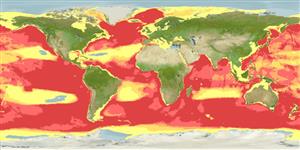Common names from other countries
Environment: milieu / climate zone / depth range / distribution range
Ecologie
Pelagisch; diepteverspreiding 0 - 342 m (Ref. 116169). Tropical; 8°C - 25°C (Ref. 75906); 90°N - 90°S, 180°W - 180°E
Circumglobal: Balaenoptera borealis borealis: Greenland, Iceland, Norway, North Carolina, Bay of Biscay, Mediterranean Sea, South Carolina, Gulf of Mexico, Bay of Campeche, Caribbean Sea, Cuba, Anguilla, Morocco, Mauritania, Alaska, Bering Sea, Gulf of Alaska, Japan, Southern California, Ogasawara, Mexico, Islas Revilla Gigedo (Pacific Ocean); Balaenoptera borealis schlegellii: Antarctica, Brazil, Angola, South Africa, Western Australia, Cook Straits, New Zealand, Peru, Java Indonesia (Ref. 1522).
Length at first maturity / Size / Gewicht / Leeftijd
Maturity: Lm 1,330.0 range ? - ? cm Max length : 1,800 cm TL mannelijk/geslacht niet bekend; (Ref. 1394); Maximaal gepubliceerd gewicht: 30.0 t (Ref. 1394)
Largest of the sei whales. As the larger rorquals became scarce in recent decades, hunting pressure on sei, Bryde’s, and minke whales increased, largely in the Antarctic. Although heavily depleted, sei whales have recovered somewhat more successfully from hunting than other large baleen whales (Ref. 1394). Generally found in coastal, shelf and oceanic waters (Ref. 122680). Feeds at the shelf break and seaward throughout the summer (Ref. 96832). Restricted to mid-latitude temperate zones (Ref. 1394). Uses both skimming and gulping as feeding strategies (Ref. 122680). Skims copepods and other small prey types (Ref. 1394); also feeds on squids (Ref. 122680), euphausiids and a variety of fish including saury and whiting. Also a "swallower." Zooplankton concentrations influence where the whales feed. Migratory (Ref. 96832). Commonly in groups of 2 to 5 individuals (Ref. 801).
Jefferson, T.A., S. Leatherwood and M.A. Webber. 1993. (Ref. 1394)
Status op de Rode Lijst van het IUCN (Ref. 130435)
Status bij CITES (Ref. 108899)
Gebruik door de mens
Visserij: commercieel
FAO - Visserij: landings, soortsprofiel | FishSource | Sea Around Us
Tools
Internet-bronnen
Estimates based on models
Preferred temperature
(Ref.
115969): 0.2 - 3.1, mean 1.5 (based on 19380 cells).
Kwetsbaarheid
Very high vulnerability (90 of 100).
Prijsklasse
Unknown.
